Basic Principles - Cell Assays
The basic principles of using magnetic detection with MNPs for immunoassays were first published by Kötitz in 1995. In magnetic assays, the MNP is the label. Our magnetic assays are all conveniently performed in microwells.
The figure below illustrates the principle of magnetic detection as applied to cell assays. Magnetic nanoparticles conjugated to detect antibodies against a cell surface antigen are added to microplate wells containing the target cells and incubated. To measure, the samples are briefly exposed (<1 sec) to a magnetic field applied with a small external magnet. This aligns all the dipole moments of the MNPs. The magnetic field is then removed and the samples are quickly moved (rotated) past the magnetic sensor that is located in very close proximity (in a manner roughly analogous to a hard disk drive).
A key point is after the external magnetic field is removed, the dipole moments of the unbound MNPs randomize very quickly (under 10ms for MNPs <300nm size) due to Brownian motion as the MNPs physically rotate in solution. Thus very soon after removal of the field, there is no net signal from the unbound MNPs.
MNPs bound to the cells have limited mobility (Brownian time constant >400 sec for 10 µm size cells) and their dipole moments remain aligned for relatively long periods of time, which is governed by Néel relaxation. After the field is removed, a net remanent magnetic signal can be measured proportional to the number of bound MNPs and thus the number of labeled cells. The high sensitivity stems from the use of our SQUID magnetic sensor, which can detect extremely small magnetic fields and hence can measure very small numbers of MNPs (1,000-2,500 MNPs).
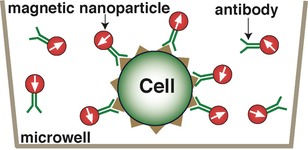
1. Add magnetic nanoparticle labels coated with detection antibody. Antibodies bind MNPs to surface antigen on target cell.
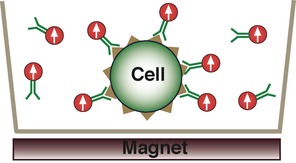
2. Apply magnetization field by moving sample over external magnet. All magnetic nanoparticle dipole moments align with the external magnetic field.

3. Remove sample from magnetic field, unbound labels quickly randomize, no net magnetic signal. Measure magnetic signal only from bound labels as all bound labels remain aligned with field.
Note cells are large and remain stationary over time window of measurement.
Basic Principles - Sandwich Immunoassays
The basic principle for a sandwich immunoassay is similar to those described above for the cell assay. Non magnetic microspheres are used to capture the target antigen in solution (improving kinetics compared to capturing on the microwell surface).
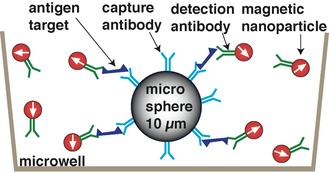
1. Bind target antigen to microsphere coated with capture antibody. Sandwich antigen with magnetic nanoparticle labels conjugated to detection antibody.
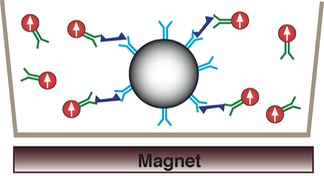
2. Apply magnetization field by moving sample over external magnet. All magnetic nanoparticle dipole moments align with the external magnetic field.
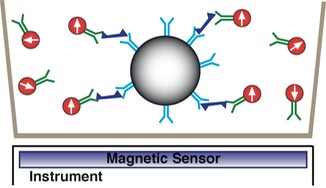
3. Remove sample from magnetic field, unbound labels quickly randomize, no net magnetic signal. Measure magnetic signal only from bound labels as all bound labels remain aligned with field.
Note that non magentic microspheres are large and remain stationary over time window of measurement.
